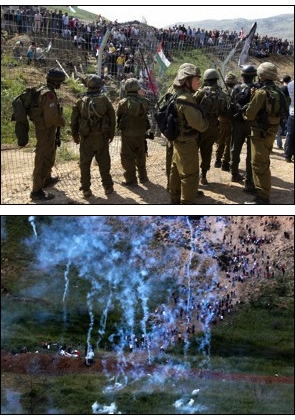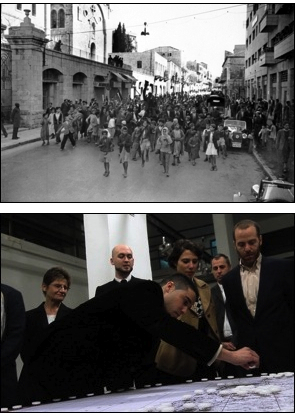Revolution : Ariella Azoulay
|
The Struggle Over Palestine as the Last Place in the World On the world map, almost completely covered with nation-states, there is a single, small, yellow, persistent stain that has not yet been taken in by the world alliance that stabilizes the differential body of the governed as an exclusive political model. At different moments during the past sixty-four years, perhaps its inhabitants—including those who have been expelled and live in refugee camps—have been willing to adopt the Here, on a miniature scale, is the nation-state’s persistent struggle against citizens. Palestinians, expelled from their land over sixty years ago, flock towards the northern border of the State of Israel in a non-violent procession. They insist on not letting the nation-state logic eliminate their civil claim, and they non-violently embody the obvious—they wish to return to and live in the place from which they were expelled. From the nation-state’s point of view, they will be recognized, at best, as refugees—“a problem” that can and must be solved between nation-states, of course. The expelled Palestinians’ years-long insistence not to be naturalized in the states to which they were exiled, is not the perpetuation of their condition as refugees (as it is commonly described), but rather the refusal to be reduced to a problem that others might solve and the insistence not to give up the possibility of civil existence in their land. It is the the insistence to live under a regime in whose shaping they would take part and that would not discriminate against them for their origin. The soldiers guarding the state border against them, representing nation-state logic, see them as an external threat—“infiltrators,” “terrorists,” or “enemies” and flood them with teargas. An anti-colonialist point of view that relates to the Palestinians as “occupied” or “stateless” presupposes the nation-state as a given (from which the Palestinians are deprived) and implies acceptance of the point of view of a regime (established on the basis of the Palestinians’ expulsion) that constitutes the Palestinians as those In the Central Zionist Archive there is not a trace of the possibility that we are looking at a reasonable civil opposition to a “solution” imposed upon the land’s inhabitants. The photograph was filed along with a description: “Jerusalem, Arab riots, an Arab mob marching in Mamila Street.” This description suited the Zionist narrative according to which the War of Independence “broke out” at that moment, as if the two sides—Arabs and Jews—were at that time two homogeneous sides with necessarily opposed political aspirations. The The demonstrators marching along Mamila Street did not threaten the sovereignty of a national entity nor did they fight it, as it didn’t exist at the time. They were a part of the population who opposed dividing the land along ethnic and national lines. Indeed there were those who already saw this division as a catastrophe. They were racing against time and acting to prevent the disaster. Everywhere throughout the country, in hundreds of localities, Palestinians and Jews signed civil agreements, solved local conflicts, and made alliances, promises, and proclamations.15 But to no avail. Ruling revolutionary violence was well on its way with a sole objective—to abolish the old regime. Not the ruling power embodied by the British Mandate—which was on its way out already—but the elimination of a regime under which Jews and Arabs lived together. A look at the violent scenes of the time reveals the essence of that violence—separation—a separation of populations so that the body politic of the governed would enable the constitution of a new regime. That is precisely the violence of ruling revolution—a separating violence that aims to produce a new civil order by exerting force. 15. See my film documenting 100 such contracts, the tip of the iceberg. Ariella Azoulay, Civil Alliance 47-48: http://www.youtube.com/watch?v=lqi4X_ptwWw↩ |

 model of the nation-state if this were made possible for them, and become a state as all others. For various reasons which I shall not elaborate here, this possibility has been consistently denied to them so that today, without anyone having meant it, the place has become a singular spot in the world where one might still hold one’s own. Instead of letting the nation-states achieve a sweeping victory, one might stand up as citizens and say no. Say no to ruling power. Say, either all citizens, or nothing. Look at the images and imagine the potential.
model of the nation-state if this were made possible for them, and become a state as all others. For various reasons which I shall not elaborate here, this possibility has been consistently denied to them so that today, without anyone having meant it, the place has become a singular spot in the world where one might still hold one’s own. Instead of letting the nation-states achieve a sweeping victory, one might stand up as citizens and say no. Say no to ruling power. Say, either all citizens, or nothing. Look at the images and imagine the potential. who do not take part in the body politic. In order to enable the appearance of Palestinians, not as an embodiment of the political categories that the nation-state has violently attributed to them—“refugees” or “stateless”—but rather as citizens just like all those who are now congregating in the ‘occupy’ movements the world over, one should go back in time, to the singular moment in which the Palestinians were equal to all humans—citizens first and foremost. Here they are (in the image below)—they, their parents, or grandparents, a short while before they were expelled from their homes, their land, the public sphere which they shared with Jews. Several days after the UN resolution regarding the Partition Plan (November 1947), they gathered from various localities and filled Jerusalem’s Mamila Street long and wide—as citizens certain of their right to public space; their right to express opposition to a political plan designed to reshape their lives; their right to oppose the nature of political life in their land that had been part of a regional space in which borders played an utterly marginal role. At the head of the procession some children scamper and applaud, and repeat the adults’ slogans. Since they ventured forth on a non-violent protest, the children were allowed to lead it on their own.
who do not take part in the body politic. In order to enable the appearance of Palestinians, not as an embodiment of the political categories that the nation-state has violently attributed to them—“refugees” or “stateless”—but rather as citizens just like all those who are now congregating in the ‘occupy’ movements the world over, one should go back in time, to the singular moment in which the Palestinians were equal to all humans—citizens first and foremost. Here they are (in the image below)—they, their parents, or grandparents, a short while before they were expelled from their homes, their land, the public sphere which they shared with Jews. Several days after the UN resolution regarding the Partition Plan (November 1947), they gathered from various localities and filled Jerusalem’s Mamila Street long and wide—as citizens certain of their right to public space; their right to express opposition to a political plan designed to reshape their lives; their right to oppose the nature of political life in their land that had been part of a regional space in which borders played an utterly marginal role. At the head of the procession some children scamper and applaud, and repeat the adults’ slogans. Since they ventured forth on a non-violent protest, the children were allowed to lead it on their own. Jewish opposition to the Partition Plan was erased from history books in a way that enabled the lie to be instilled—that only the Arabs opposed the plan while all the Jews desired and gladly adopted it. In order to suppress the civil aspirations that were widely expressed in the 1940s, massive regime violence was needed, and was essentially meant to suppress civil aspirations and to create conformity between the ruling position and the body politic of the governed. The hundreds of thousands of Palestinians who were expelled from their homes were not enemies and posed no threat to the continued Jewish existence in Palestine. Regarding that period, without casting the war within a narrative framework and without projecting it back in time, the existence of two sides in combat is not the cause of violence but its outcome.
Jewish opposition to the Partition Plan was erased from history books in a way that enabled the lie to be instilled—that only the Arabs opposed the plan while all the Jews desired and gladly adopted it. In order to suppress the civil aspirations that were widely expressed in the 1940s, massive regime violence was needed, and was essentially meant to suppress civil aspirations and to create conformity between the ruling position and the body politic of the governed. The hundreds of thousands of Palestinians who were expelled from their homes were not enemies and posed no threat to the continued Jewish existence in Palestine. Regarding that period, without casting the war within a narrative framework and without projecting it back in time, the existence of two sides in combat is not the cause of violence but its outcome. 